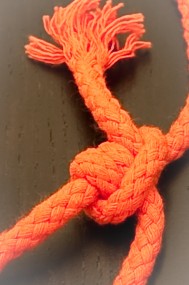Humans have been using rope as a tool for thousands of years, even before we started recording history. Knots and rope-tying is one of the few technologies that have persisted essentially unchanged in all of the known human history. As you can imagine, there are different knots for different applications, and in this series of posts, I would like to share with you the knots that I’ve found most useful both at home and outdoors.
The Tautline Hitch
It is very common to want a taut line (rope) between two objects. In these cases it is not enough to just connect a rope to the two endpoints. The rope must also stay stretched and not sag. If you’ve ever had to tie a volleyball net or a tent guy line to a stake, you know difficult it is to tie the knot at just the right place to keep the line tight. It doesn’t help when the line sags every so often and needs to be retightened.
The tautline hitch knot is perfect for this application. It makes a loop in the rope and the position of the knot affects length of the loop. The more you move the knot towards the opposite end of the rope, the tighter the line gets. The knot is like a ratchet. It can be slid up and down the rope, but it does not slide when the rope is under tension. It only moves when you hold the knot and push it one way or the other. This way when a rope sags, you can hold the knot and move it from one endpoint to the other without having to untie the knot and retie it.
There are many resources out there for learning how to tie knots. My favorites are the Klutz Book of Knots, The Complete Book of Knots, and the Animated Knots website. Of course, no discussion on knots can be complete without mentioning the definitive reference, Ashley Book of Knots, with more than 3,900 different knots and 7,000 illustrations.

